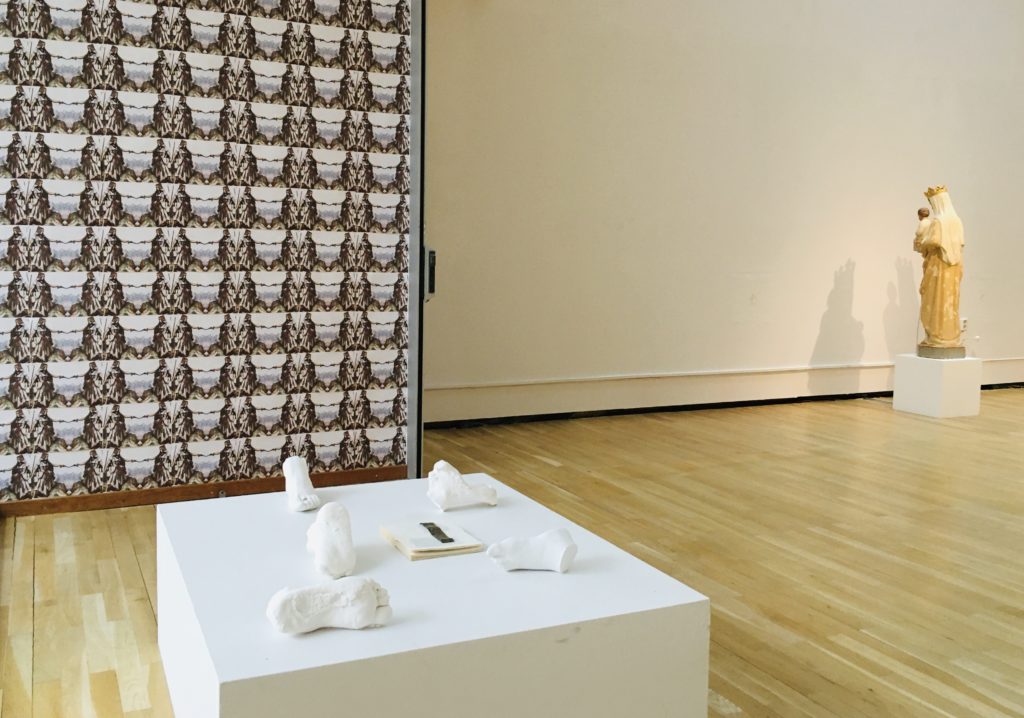During the last centuries, both the Arab invasion and France’s colonial politics have contributed to a specific male gaze on Algerian women, that has been emphasized in the 1900s’ torn and unequal society. Such a gaze has deeply harmed the people as well as marginalized the native people of Algeria, the Amazigh or Berber as they are called since the Roman conquest. Particularly women were facing double oppression, both through colonial power and that of the patriarchal structure. Some of the wars’ strategies have also explicitly targeted them through controlling societal reforms such as marriage and by a physical and mental violation. A colonial trace in today’s visual culture are postcards showing unveiled (literally) Berber females photographed with bare breasts. Depicted both as exotified objects of desire and as emancipated women to promote french ideals. The aim was to destroy the image of the sacred feminine figure and to dominate the native Algerian men.
The exhibition Amina Zoubir taking a stance on berber queens: history and mythology, within the more extensive Ernest Mancoba exhibition, at Södertälje konsthall is the first solo show of the artist in Sweden. It shows a selection of sculptures, collages, drawings, wallpaper together with an installation of research compiled by the artist during the last three years. It presents the latest chapter in her ongoing exploration of female representation and women’s history in North Africa through colonial imagery and images of the Berber queens Tin Hinan (4th century), Kahina Dihya (7th century) and Lalla N’Soumer (1830-1863). Queens who ruled matriarchal societies in the Maghreb but whose history has been neglected in Algerian school education. Lalla N’Soumer, for instance, was an essential figure in the resistance movement fighting the early french colonial invasion. Tin Hinan walked across the Sahara desert to escape the Roman oppression. Kahina Dihya was decapitated due to her influential position while leading troops against the Arab invasion. So, what role can these postcards and the imagery of Berber queens play today, and how have these images been inscribed in contemporary representations of female bodies, the artist asks herself.
In Zoubir’s work, she processes the destructive history folded within the colonial images by repeatedly drawing the women from the postcards in real body size. As a counteract, she gives body to the oral stories about the Berber queens by sculpting Tin Hinan’s feet and Kahina Dihya’s confident face — embodying their strength and materializing a presence. Simultaneously she deconstructs a collection of original colonial postcards by cutting them into small pieces to assemble them into new forms — revealing a fragility of its earlier eroticised concept. Her methods call to mind philosopher Gilles Deleuze understanding of “difference” and “repetition” (Deleuze, 1968), which assays a critique of representation. For him, every repetition brings something unique to occur. It is also what lays in between the difference of the repetition that accounts for change — for evolution, for creativity.
In contrast to the collages, Zoubir’s wallpaper is at first glance a seemingly simple systematic repetition of a mirrored image of the female warrior Lalla N’Soumer in fighting position, with a gun. However, the mirror effect makes the two pointed gun barrels meet — causing the weapons’ force to implode. As if the artist attempts to test both the potential and the inability of such images today. In her work, by employing the idea of repetition Zoubir underlines a familiar dichotomy: the woman as a prostitute (the colonial postcards) and as heroic figure (the Berber queens) — “revealing” them as women, i.e. human beings — at the same time she discloses them as myths. Deleuze says when declaring the essential logic and metaphysical aspects of “repetition” and “difference”, prior to any concept of identity: “Identity and resemblance would then be no more than inevitable illusions – in other words, concepts of reflection which would account for our inveterate habit of thinking difference on the basis of the categories of representation.”
In Zoubir’s earlier work, such as the performance series Prends ta Place – Take Your Place (2012) performed in Algiers at Moorish coffee salons, streets, soccer stadiums, beaches, hair salons and clothes markets, as well as in her exploration of female representation in North Africa show a fundamental need for reliable images of women living in the country today and female presence in public space. This makes me think of what psychiatrist and political philosopher Frantz Fanon, who supported the Algerian War of Independence, once wrote: “In the World through which I travel, I am endlessly creating myself.” (Fanon, 1952). To me, he points to the complexity of, and the fundamental in, society’s impact on the physical body and psyche. For Ernest Mancoba artists (African) must identify what they need to hand over to the next generations, as he saw art as an extension of humanness. Zoubir makes us aware of creating a distanced gaze to established imagery as well as myths of women, to open up for substituted challenging concepts through art.
Sara Rossling is an independent curator and writer currently based in Stockholm. She has an interest in processes of rewriting history, cross-disciplinary thinking, collectivity and artistic response to societal issues. She works with exhibitions, research-based art projects and writing. Her latest show is UNDER SKIN with artist Marcia Kure at Rutiga Golvet — a meeting space for art theory, publication and exhibitions at Royal Institute of Art Stockholm.
Thanks to Iaspis, the Swedish Arts Grants Committee’s International Program.
Video: Conversation between Amina Zoubir and Joanna Sandell, director Södertälje konsthall on the exhibition Amina Zoubir taking a stance on berber queens: history and mythology.
April 27 2020.
Gallery name: Södertälje Konsthall
Address: Lunagallerian, Storgatan 15, Södertälje
Opening hours: Tue 10:00 - 18:00, Thu-Sat 12:00 - 15:00
Open: 30.04.2020 - 27.06.2020







